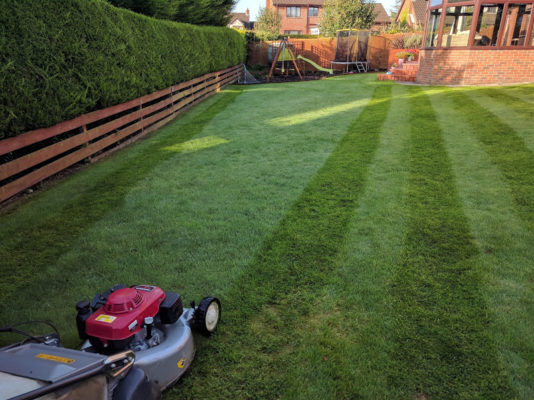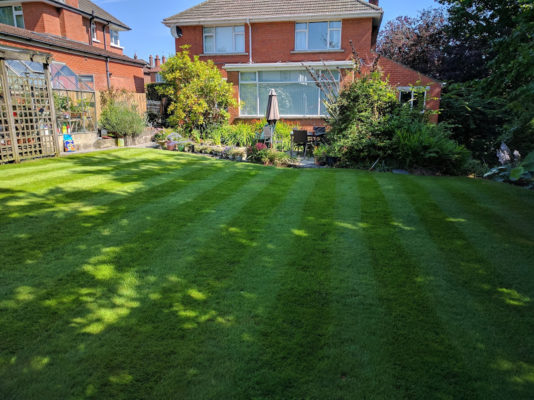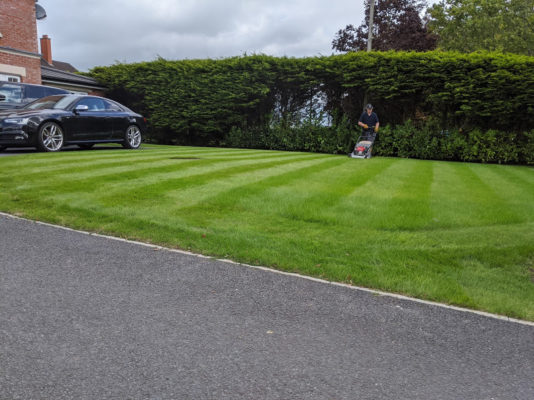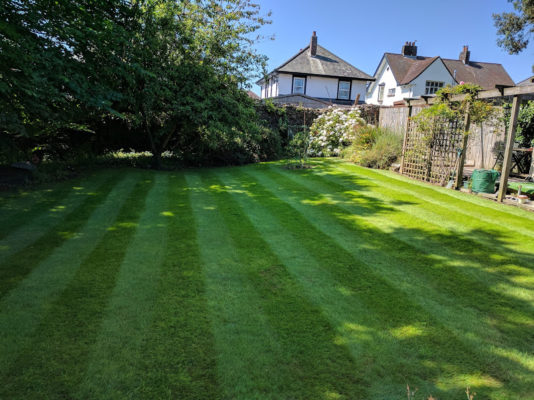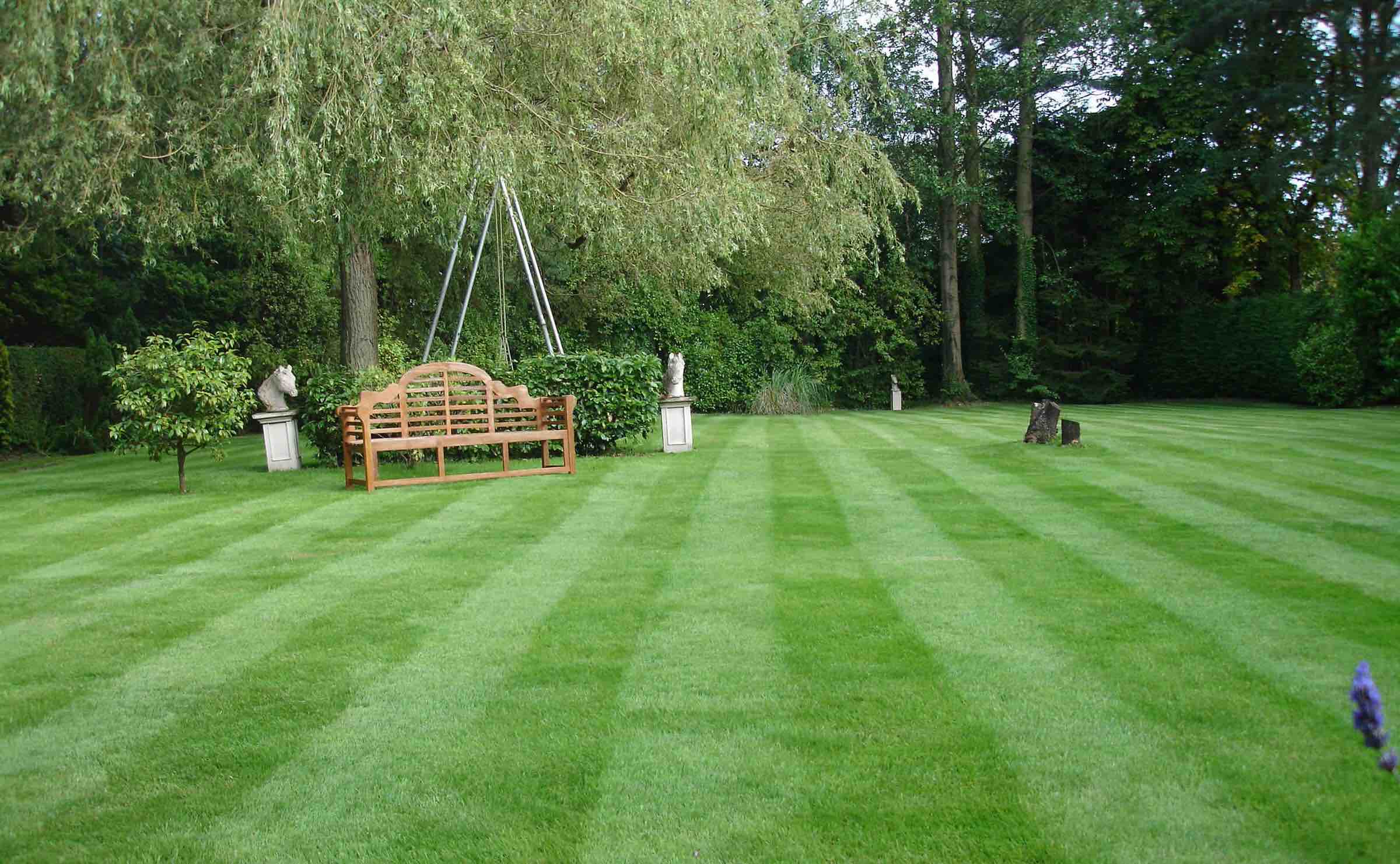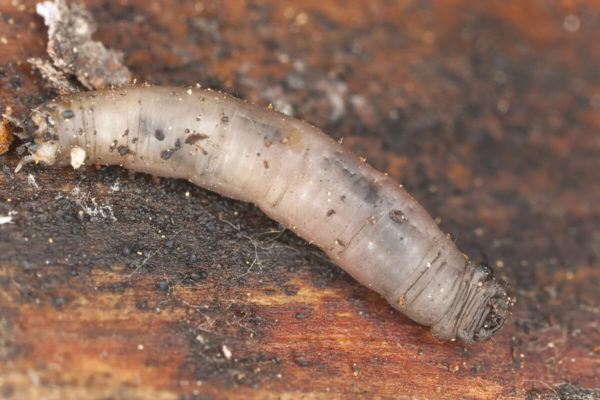Why it is important to mow your lawn?
A proper lawn mowing regime is one of the most important things you can do for an established lawn. Not only does a neatly cut lawn keep your garden looking well, removing the tips of the plant encourages growth and a denser, healthier grass sward. Mowing is also fun to do, gives great satisfaction, and it is good exercise.
Read on for our tips on how to get the most from your lawn mowing routine.
What is the best grass cutting height for my lawn?
- The best grass cutting height for a lawn depends on the grass species, the weather, where you live, and how you use and maintain your lawn. But as a general rule of thumb when you mow an established lawn you should never remove more than one third of the grass blade – this is known as the one third rule of lawn mowing.
- Never let the grass grow really long and then mow it short, this will weaken the plant enabling moss and weeds to invade, it can also lead to pale uneven coloured patches in the lawn rather rich green colour overall.
- When grass cutting in winter be particularly careful not to scalp the grass and be sure to raise the height of the mower blade.
How often should I mow my lawn?
Mow when the grass is ready to be cut. During UK lawn mowing season (beginning of March to the end of October) the grass should usually be cut every 7-14 days depending on growth. Over the winter months, mow as and when needed and as providing ground conditions allow.
Lawn Mowing in Spring and Summer
- Grass grows quickly during these seasons and you should mow every 7-10 days.
- Always stick to the one third rule.
- If there is an exceptionally dry period, cut with the box off and leave the clippings on the lawn as this will help to prevent any water that is in the lawn from evaporating.
- If it is so hot that the grass stops growing, then do not mow.
- Sit back, relax, and enjoy summer on the lawn
Autumn / Winter Lawn Mowing
Growth slows down in winter, but if there is a mild spell it will still continue to grow and if this is the case you can mow the lawn in winter providing conditions are suitable. This will help keep the lawn tidy and stop the grass from getting too long. When grass cutting in winter you must stick to a few common-sense rules:
- Never mow if there is a frost, snow, or the ground is soggy wet.
- Put the lawnmower on the highest setting, as leaving the grass a bit longer during winter will help protect it.
- Remove fallen leaves from the lawn before mowing.
- Remove all debris such as sticks and branches before mowing.
- Remove all grass clippings as these can block sunlight from getting to the lawn and cause moss and thatch build-up and diseases.
- Service the lawnmower when you have finished cutting for the season (we usually do this before Christmas), to get it ready for the following year.
How to mow stripes
Stripes in a lawn are formed when sunlight reflects off grass blades are pushed in opposite directions. Here’s how to do it:
- You will need a lawn mower with a rear roller attachment.
- Firstly, start by mowing a turning stripe the whole way around the outside of the lawn. Do this by mowing two widths of the mower around the lawn in opposite directions. This will also act as an indicator of when to turn when mowing.
- Find a straight edge to focus on.
- Now mow your first straight line, focusing on your straight edge to keep your line straight.
- Mow the second stripe alongside the first one, but in the opposite direction.
- Try to keep the width of the stripes the same, using the first stripe as a guide.
- Keep mowing until the whole lawn is striped up.
- To finish, mow around the edge again – this will give a sharp professional finish.
It takes a bit of practice, but once you have mastered how to stripe up your lawn it gives great satisfaction, is aesthetically pleasing, and can trick the eye and make the lawn look bigger.
How to edge a lawn
- Cut the grass first, but do not mow right up to the edge. This will let you see how much excess is overflowing so you know how much will need taken off.
- If your lawn has never been edged before or has been neglected for a while you will need to use a half moon edging iron or use a spade. We love to use our Milwaukee M18 Fuel Quik-Lok Edger Attachment, but if you don’t have a mechanical tool and manual tool will do the job.
- Start by running a string along the edge of the lawn to mark out a straight edge
- Then dig into the ground with your half-moon iron, or spade to cut a straight edge, removing the debris as you go along.
- If any bits of grass are still sticking out use garden shears to cut them off.
- Going forward, after your weekly grass cut trim the edges with garden shears to leave a neat finish.
A sharp well-defined edge really sets of a neatly cut lawn, and it helps the lawn stand out by creating a contrast between where the lawn ends, and the rest of the ground begins.
Mowing a new lawn for the first time
- Ensure the grass plants have rooted in well before mowing.
- If your lawn is newly turfed grab a handful of grass and tug, if you can feel the earth move then the roots need a little longer to settle in before mowing.
- If your lawn is newly seeded the general rule of thumb is that the first cut can be done when the blades are around 6-7 cm long.
- Ensure your mower blades are really sharp, not only will this leave a nice razor-sharp finish it will also help prevent disease.
- Collect all clippings after mowing.
- Never mow if there has been a frost or the ground is soggy wet.
- Do not take off more than ¼ of the blade for the first few cuts of a new lawn, then follow the one third rule from then on in.
- If the weather is very dry, water your new lawn immediately after mowing.
What type of lawn mower should I use?
This depends on a number of factors:
- The size of the lawn
- The type of grass in your lawn
- The ground conditions where you live, if it is even or bumpy and if you are on a slope or flat
- The cut finish you are hoping to achieve
- Your budget
Whichever type of mower you opt for, what is essential in all cases is that you clean the underside of the mower after cut, keep the blades sharp to ensure a neat finish, and that you have the machine serviced annually.
If you need help with cutting the grass our lawn mowing service covers Belfast, Jordanstown, Whiteabbey, Newtownabbey, Greenisland, Carrickfergus. Further information on our grass cutting service is available here.
What is the best grass seed for your lawn?
Whether you are repairing or replacing a lawn, choosing the right seedmix is imperative. So[...]
Apr
Controlling Leatherjackets In Your Lawn
Leatherjackets, just one example of how Mother Nature keeps lawn owners on their toes. In[...]
Mar
Get in touch
Getting a call back is quick and easy, submit your name, number and email.
We will call you back to arrange a quote.
Please put as much information about the job as possible.
Get in touch today and find out how easy it is to have a Premier Lawn & Garden.




